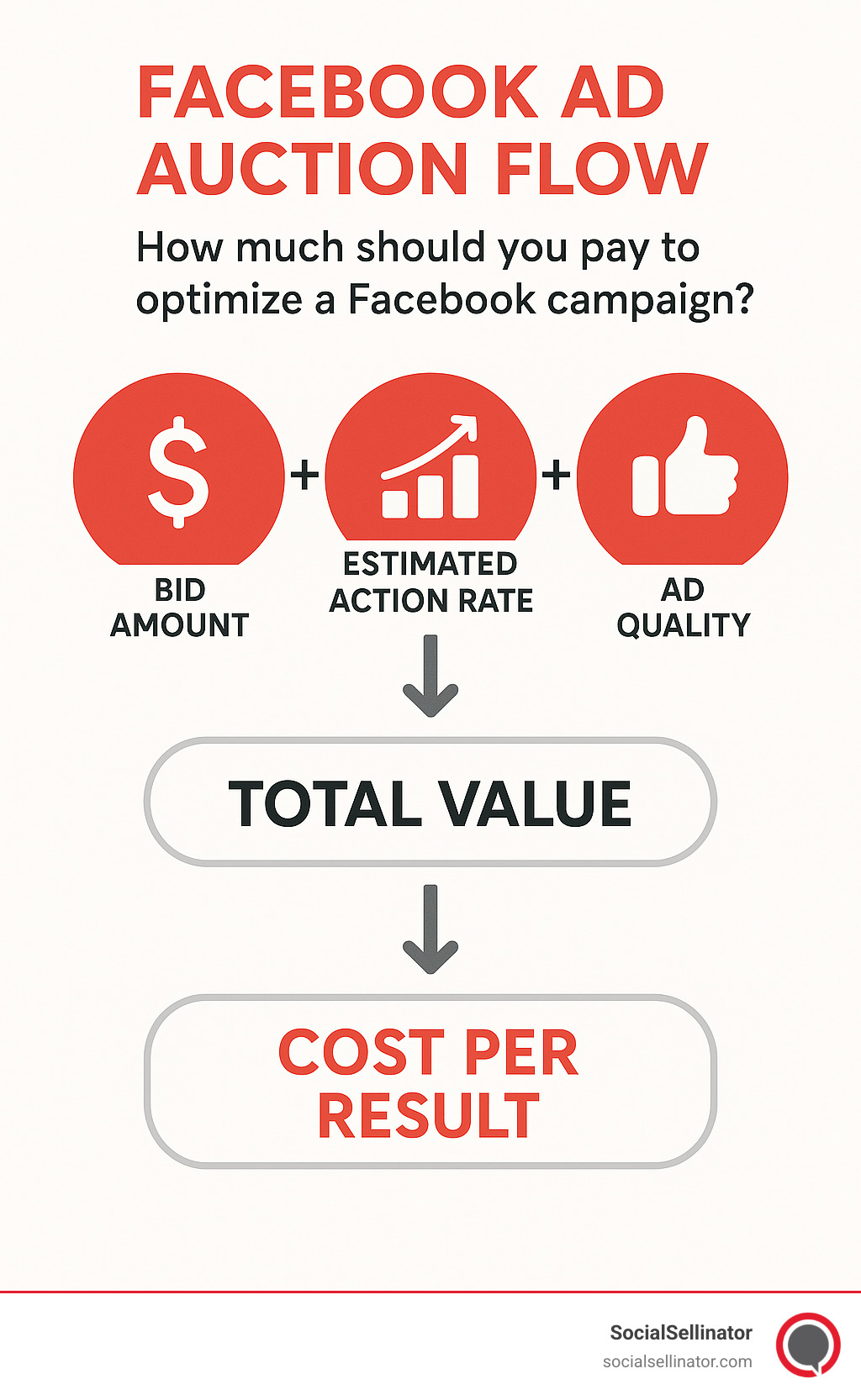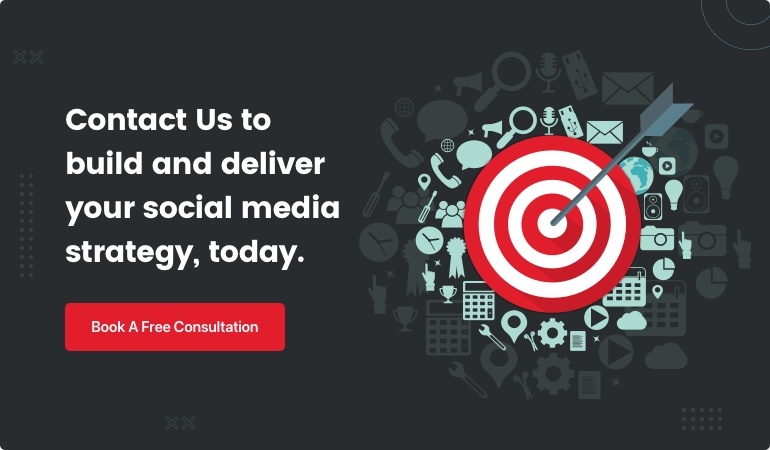Why Facebook Campaign Costs Are Getting Out of Hand
If you're wondering how much should you pay to optimize a facebook campaign, here's the quick answer most marketing managers need:
• Minimum viable spend: $5-10/day per ad set to gather meaningful data
• Learning phase requirement: Budget for at least 50 optimization events per week
• Industry benchmarks 2024: Average CPC $1.68, CPM $8.70, CPA $19.68
• Rule of thumb: Start with $1 for every 100 monthly website visitors
• Scaling recommendation: 5-15% of total revenue for established businesses
You're not alone if your Facebook ad costs feel like they're spiraling upward. With over 3 million active advertisers competing in Facebook's auction system, costs have jumped significantly—CPM spiked 122% after Facebook's algorithm changes prioritizing friends and family content over brand posts.
The frustrating truth? Most businesses are overpaying because they don't understand Facebook's auction mechanics. Unlike Google Ads where you bid on keywords, Facebook uses a complex system weighing your bid amount, estimated action rates, and ad quality scores. This means two advertisers targeting the same audience can pay vastly different amounts for the same result.
The real challenge isn't just setting a budget—it's optimizing every dollar within Facebook's ever-changing algorithm. Small tweaks to your targeting, creative quality, or bid strategy can cut costs by 30-50% without sacrificing results.
Whether you're spending $500 or $5,000 per month, the principles remain the same: understand the auction, optimize for quality over quantity, and scale based on data rather than gut feelings.

How the Facebook Ad Auction Really Works – and Why Your Costs Swing So Much
Think of every impression on Facebook as a miniature bidding war. Because it’s a second-price auction, you never pay your full bid; you only pay the penny-over amount required to beat the next best advertiser. Three variables decide who wins:
- Bid amount – what you’re willing to pay.
- Estimated action rate – Facebook’s prediction that a user will take your chosen action.
- Ad quality / relevance – signals from user feedback, hide rates, and engagement.
Facebook multiplies those three inputs into a single “total value” score. Highest total value wins the auction, not necessarily the highest bid. That’s why two advertisers targeting the same audience can see wildly different costs.
Bid, Budget & Pacing – Your Three Cost Levers
• Bid strategy (lowest cost, cost cap, bid cap) tells Facebook how aggressive you’ll be.
• Budget sets the total amount the system can deploy.
• Pacing is Facebook’s autopilot that spends faster or slower depending on how close you are to exhausting budget.
Get any one of those levers wrong and you’ll overpay, sometimes by 30–50%.
What You Can Control
• Ad quality – Better creative gets rewarded with cheaper CPMs.
• Audience size – 10k-100k is the “Goldilocks zone” for most campaigns.
• Creative fatigue – Refresh after frequency 3–4 or every 7-14 days.
• Placement mix – Automatic placements usually beat manual by 20-30%.
Tweak those inputs first; they have the biggest day-to-day impact on how much you ultimately pay.
How Much Should You Pay to Optimize a Facebook Campaign?
Facebook will technically let you run ads for as little as $1/day, but real optimization starts when you can generate 50 conversion events in a week. Use the quick-glance table below to see if your budget matches your goals:
| Goal | Bare-bones daily spend | Reliable data daily spend |
|---|---|---|
| Impressions | $1 | $5+ |
| Clicks / Traffic | $5 | $20+ |
| Conversions / Leads | $10 | $50+ |
2024 platform averages are a helpful yardstick but not gospel:
• CPC: $1.68
• CPM: $8.70
• CPA: $19.68
• CPL: $5–8
Geography matters just as much as industry. A 1,000-impression buy might cost $20 in the U.S. and only $7 in Japan. Always weigh cost savings against customer lifetime value.
Minimum vs. Recommended Spend
• Testing phase: $5–20/day per ad set for 5–7 days.
• Scaling phase: $100–500/month for smaller brands; grow budgets 20–30% weekly once ROAS is stable.
• Rule of thumb: Allocate 5–15 % of total revenue to Facebook if the channel is a primary growth driver.
Use your break-even CPA as the North Star. If your average order value is $100 at 30 % margin, your max CPA is $30. Spend up to that figure, not past it.
Budget Levers: Objectives, Targeting, Placements & Creative Tweaks
Your objective is the biggest price signal you send to Facebook:
• Awareness = cheapest reach, lowest intent.
• Consideration = middle-of-funnel, balanced costs.
• Conversion / Sales = highest intent, highest cost.
Start cold audiences on traffic or engagement, then retarget warm prospects with conversion campaigns once you gather at least 50 conversion events.
Objective Costs at a Glance
| Objective | Typical CPC / CPV | Typical CPA |
|---|---|---|
| Traffic | $0.90–$1.75 | — |
| Video Views | $0.02–$0.06 | — |
| Conversions | — | $5–$50+ |
Audience & Placement Hacks
• Broad targeting often beats hyper-detailed interests—Facebook’s AI finds buyers if given room.
• Enable detailed targeting expansion to drop costs 20–40%.
• Reserve ~⅓ of budget for retargeting (website visitors, email list, purchasers).
• Stick with automatic placements unless legal or branding restrictions require manual.
Creative Quality = Cheaper Results
The first three seconds decide your CPC. Video usually wins, but only if it grabs attention instantly. Test 3–5 variations, kill losers after 72 hours, and refresh creatives once frequency tops 3.
Smart Bidding & Automation Strategies to Stretch Every Dollar
Start every campaign with Lowest Cost bidding for 10–14 days—it lets the algorithm learn your audience cheaply. Once you know your true CPA, switch to Cost Cap to keep results under that ceiling.
| Bid Type | Best Use | Risk |
|---|---|---|
| Lowest Cost | Launch & testing | Less cost control |
| Cost Cap | Steady scaling | Volume may dip |
| Bid Cap | Regulated industries | Requires micromanagement |
Scaling Without Breaking the Algorithm
• Increase budgets 20–30 % every 3–7 days if ROAS ≥ target and frequency < 3.
• Pull back if ROAS drops 30 % or CPA jumps 50 % for 3+ days.
Let Automation Catch Expensive Surprises
Set Meta automated rules to:
- Pause ad sets when CPA > 150 % of target.
- Increase budget 20 % when ROAS beats goal 3 days straight.
- Email you if spend spikes 50 % day-over-day.
That single setup has saved some of our clients thousands of dollars in “overnight creep.”
Tracking, Benchmarks & a Simple Optimization Rhythm
Prioritize ROAS and CPA—everything else is diagnostic. When costs rise, check:
- CTR – targeting or creative problem.
- CPM – auction pressure.
- Conversion rate – landing-page issue.
Keep frequency under 3–4; after that you’re paying premium CPMs for annoyed eyeballs.
Quick-Start Dashboard Checklist
• Daily spend alert if > 150 % of average
• ROAS alert if < break-even
• Frequency alert if > 4
• Weekly cohort report for seasonal patterns
A Four-Week Optimization Cycle
Week 1 – scale winning ads, pause clear losers.
Week 2 – audit audiences; prune anything dragging ROAS.
Week 3 – drop fresh creative & test new placements.
Week 4 – revisit bid strategy and re-allocate budget.
Repeat monthly to keep campaigns healthy without resetting Facebook’s learning every other day.
Frequently Asked Questions About Facebook Campaign Costs
What’s the minimum spend to leave the learning phase?
Rough rule: 50 conversions in 7 days. If your CPA is $10, plan on ~$70/day until you exit learning.
My CPA is higher than industry averages—should I panic?
Not necessarily. SaaS or finance firms routinely pay $50–$200 per lead because lifetime value is high. Compare CPA to your CLV, not someone else’s benchmark.
Daily vs. lifetime budget for short promos?
Use lifetime budgets for anything under 30 days so Facebook can front-load spend on high-opportunity days. For ongoing evergreen campaigns, stick with daily budgets for predictable exposure.
How do I know if creative is the cost culprit?
Rising CPA + falling CTR + frequency > 3 usually signals ad fatigue. Swap creative before tweaking bids or budgets.
Conclusion
“How much should you pay to optimize a Facebook campaign?” comes down to disciplined testing and ruthless focus on ROI—not guesswork. Start small but sufficient ($5–10/day per ad set), push past the learning phase quickly, and scale winners in controlled 20–30 % steps.
Facebook continues to reward advertisers who pair great creative with data-driven budgeting. Even modest $500/month accounts can outperform poorly managed $2,000 budgets when every lever—objective, audience, bid, and creative—is dialed in.
Need help turning your Facebook ads into a profit engine? More info about Facebook Ads Management San Jose
Headquartered in San Jose, in the heart of Silicon Valley and the San Francisco Bay Area, SocialSellinator proudly provides top-tier digital marketing, SEO, PPC, social media management, and content creation services to B2B and B2C SMB companies. While serving businesses across the U.S., SocialSellinator specializes in supporting clients in key cities, including Austin, Boston, Charlotte, Chicago, Dallas, Denver, Kansas City, Los Angeles, New York, Portland, San Diego, San Francisco, and Washington, D.C.






